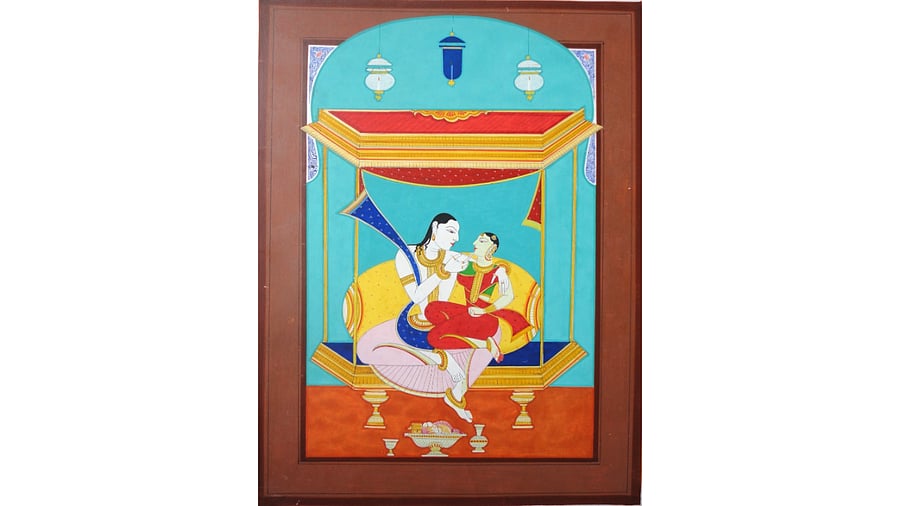
Miniature paintings by artist Vijay Hagargundagi.
Credit: Special arrangement
As the years go by, the intricate miniature art native to Surpur, a taluk in Yadgir district, seems to be struggling to stand the test of time. The rapid pace of modernisation, economic pressures and dwindled patronage have prompted many artists to switch to different careers.
The art style once flourished under the reign of Raja Venkatappa Nayak (1773-1802) and Nalavadi Venkatappa Nayak (1853-1858) of the Gosala dynasty. It prospered under the patronage of subsequent rulers as well, but the interest in the style declined significantly following Independence. Now, it is on the brink of extinction due to the lack of encouragement from the government as well as interest from the general public. Merely six to seven artists who are versed in the style are keeping the art alive.
A few artists, who have been striving to protect Surpur miniature art, have expressed concerns about its impending disappearance.
Miniature artists had migrated to Thanjavur and Mysuru after the fall of the Vijayanagar empire during the 17th century. A few of them migrated to Surpur, hence the original miniature art form still exists in the historical town. Banaiah Garudadri and his family members, artists who had migrated from Andhra Pradesh to the town, were specialised in painting pictures from Hindu mythology, as per the wishes of the rulers.
Paintings of Raghavendra Swamy, Shiva-Paravati, Lakshmi, Hanuman, Garuda and other gods and goddesses can be found commonly drawn in this style. Incidents from the Mahabharata, the Ramayana and the Puranas have also been drawn on temples and mutts. The rulers used to worship the images of the epic characters painted by the Garudadri family.
Modern legacy
Surpur miniature paintings can be found at the British Museum in London, as well as government museums in Hyderabad and Delhi, the Salar Jung Museum in Hyderabad and the Jaganmohan Palace in Mysuru.
One of the artists, Vijay Hagargundagi, has led several initiatives over the past five decades to revive Surpur miniature art. He started learning the art by collecting and replicating more than 30 old miniature paintings that locals had in their homes.
“Surpur miniature painting had become mostly extinct for almost a century. This is when I took a keen interest in reviving it, after collecting old paintings, as there were barely any teachers. There was also a lack of knowledge about the use of colours and the technique,” says Vijay.
The artist researched the style extensively and found that it managed to survive in the 18th and 19th centuries, due to royal patronage. “Now, no artists are coming forward to learn it, as it is a time-consuming process which requires a lot of patience and labour,” Vijay says.
Surpur miniature art spread from Ballari to Bidar, during the 14th and 17th centuries, under the rule of the Vijayanagar empire, and vanished after Independence. Senior artists say the style could have retained its value if government and cultural initiatives were available to support it.
Surpur miniature paintings contain elements that can also be found in other traditional art forms, but Garudadri’s paintings can be easily distinguished from them by their composition of lines and figures and also the use of gold sheets. Light yellow hues, prabhavalis and humans made of gold sheets, and deep blue shades are used in the background to give the pictures a touch of reality.
Laborious process
The artists draw Surpur miniature paintings by using handmade pigments, which in itself is laborious. The pigments are made using naturally occurring minerals and organic material. The miniature paintings are also almost exclusively painted on Wasli paper, a type of handmade paper prepared by glueing four to five layers of water-absorbent paper. In the past, many artists would stick to small miniatures due to the unavailability of such paper.
“People used palm leaves until the 17th century and paper was only used much later in south India. In the absence of paper, Surpur artists would use printed newspapers after a coat of solid colour. Due to this, artists would only paint small miniatures, which were confined to worship halls in the homes. Now, artists are not interested in doing miniature paintings despite the availability of all facilities,” Vijay says.
Artist and researcher Rehman Patel, who has worked on Surpur miniature paintings, feels that funds are not being allotted for the revival of Surpur miniature art, despite several requests made to the Karnataka Lalithakala Academy.
“Regular camps and workshops should be conducted to support Surpur miniature art. Unfortunately, this traditional art has been in a state of total neglect,” Rehaman adds.
Miniature paintings by artist Vijay Hagargundagi.
Miniature paintings by artist Vijay Hagargundagi.
Surpur miniature paintings by artist Vijay Hagargundagi.